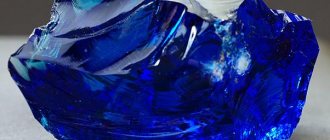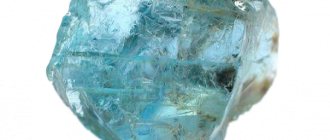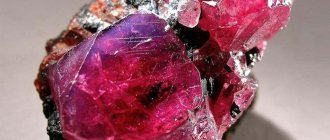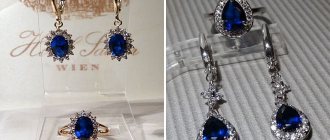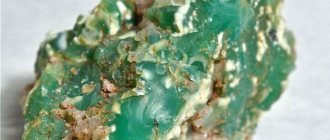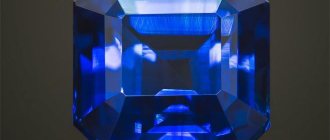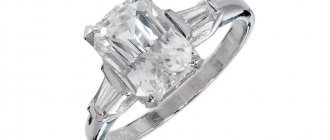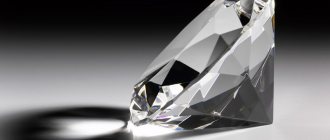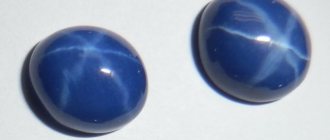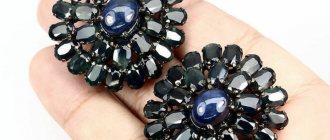Of course, if we decide to buy jewelry with a precious stone, we want it to be natural. Despite the fact that synthetics, as a rule, look much better than the originals, it is the things created by nature itself that are valuable. In the case of sapphires, this is especially important, since this mineral is counterfeited quite often. How to choose the right ring or earrings with sapphire? Read on.
Story
Sapphire is a stone that has long been highly valued for its wonderful beauty and extraordinary strength. Its discoverers are considered to be the inhabitants of the south-eastern part of Asia, who called it “corundam”. In modern mineralogy, corundum is a mineral that has quite a few varieties (sapphire, ruby, etc.).
There are many versions about where the word “sapphire” first appeared. Historians have still not come to a consensus.
- Some of them believe that from the word “sipru” - in the language of Ancient Babylon means “scratching”. Probably, the extraordinary hardness of this stone gave rise to such a designation.
- “Caniprya” is translated from the ancient Indian language as “beloved by Saturn.”
- Translation from Sanskrit is “favorite piece of heaven.”
- "Sappheiros" means "blue stone" in Greek. In Hellas, absolutely all precious blue-colored gems were called this way.
In mineralogy, the modern name of this stone comes from the Latin language - “sapphirus”.
Once upon a time, only blue corundum was called sapphire. Later, jewelers extended it to include gems of different colors, forming a specific group.
Today, for a mineralogist, “sapphire” is only blue corundum, but for a jeweler it is a group of multi-colored corundums, except red, which is called ruby.
In Russia, until the 19th century, all blue gems were called “bausami” and only sapphire had a separate name - azure yakhont.
The Romans gave corundum the name cyanus (cornflower) and dedicated it to Jupiter.
In ancient Greek mythology, sapphire is the stone of Zeus. The temple priest always had a ring with this gem.
In Buddhist cosmogony it is said that under the North Star, at the celestial pole, there is a mountain. Its four sides consist of yachts of different colors. The one facing us is lined with blue corundum, which is why the sky is also blue.
In the Middle Ages, Muslims were sure that around our world there was a mountain range called Kaff (perhaps the Caucasus), the ridge of which was lined with blue yacht. It gives blue reflections to the heavens.
An Indian legend says that the magic drops of Amrita became blue corundums. The Creator turned this elixir, which bestows eternal life, into stone so that people could not use it.
According to biblical legend , sapphire is one of a dozen precious stones that decorate the gates of the heavenly city, where God will invite every person who believes and is righteous in earthly life.
This wonderful mineral is one of the main artifacts for Christian clergy of high status. They were supposed to wear rings with this gem set in gold. Moreover, it should be natural, without jewelry processing.
Since ancient times, blue sapphire has been associated with power over a large number of people, because they believed that it harbored the power of heaven and gods.
There has long been a tradition of decorating the crowns of the rulers of countries with these gems.
According to legend, sapphires were in the crown of Queen Cleopatra. King Solomon owned the sapphire seal.
History and origin
The gem was first discovered and appreciated for its extraordinary beauty, unique properties and strength by residents of East and South Asia. They gave it a name - corundum. Later it became known as sappheiros. In translation - a precious stone. Then Johan Wallerius (a naturalist from Sweden) proposed calling only a mineral of exclusively blue color sapphire. All other shades were classified as nuggets. Although the history of the stone is so mysterious that several versions of its origin are known:
- Sapphire has Jewish or Babylonian roots. The mineral is called a piece of beloved heaven due to its high hardness.
- Sapphire got its name “scratching” due to its high hardness and ability to scratch the surface of other gems. At the same time, he himself remains safe and sound.
- In India, the stone is compared to the elixir of eternal life. According to legend, one creator made sure that the miraculous liquid turned to stone and did not reach the common people.
Sapphires were first synthesized by the French chemist Auguste Victor Louis Verney, when the first artificial specimens appeared in 2004. In Russia, the mineral was called bays, lapis lazuli, azure Yakhont. The very concept of sapphire is ambiguous among mineralologists and jewelers. Some call only the blue gem by this name. Others are all shades except red corundum, called ruby.
Reference! The largest stone in history (weighing 3,500 carats) was found by radiologist Steve Mayer in the 60s of the 20th century. At first I took it for rock crystal. But after taking it to a specialist, it was confirmed that the specimen belongs to sapphire.
Where are sapphires mined on an industrial scale? These are the USA, China, India, Vietnam, Australia, Burma. In Russia, individual specimens of a cornflower-blue, gray hue are found on the Kola Peninsula and the Urals.
Where is it used?
Taking into account its properties and origin, the stone is used in the technical and jewelry industries. The main area is the fashion industry, where gems of different colors are used to make women's and men's jewelry. Dark blue and black shades are used to decorate ties, cufflinks, bracelets, and rings. Blue sapphire goes well with platinum and gold, so it is often combined by jewelers. Gentle pink shades are preferred by fans of glamor.
The mineral is particularly durable. It has found wide application in technology, science, and industry. Namely, in the manufacture of eye lenses, implants, braces, microcircuit elements, thermal insulation materials, laser technology, windows on space stations, and other high-strength optical elements.
Corundum produces super-strong glass, which can be found on mobile phones and premium watches.
Attention! Sapphire is an expensive stone. Frames from it in the manufacture of rings, pendants, necklaces, bracelets, and earrings are made mainly from silver, gold, and platinum. Sometimes a cabochon is used as a cut.
Characteristics of the stone
Sapphires are crystals belonging to the corundum class, which consist almost entirely of aluminum oxide. Their chemical formula is Al2 O3 .
What color it is is determined by impurities; the more of them, the richer the color. This stone has the following characteristics:
- extreme hardness ( 9 on the Mohs scale , higher - only diamond);
- high strength;
- strong glass luster;
- porous structure (which is why perfectly clean stones are very rare);
- transparency, which varies.
If the crystal is exposed to high temperatures, it becomes discolored. X-rays, on the contrary, make the color more saturated (in this case, corundum is called refined).
Sapphire mineral: properties and description, formula
Sapphire mineral photo
From a scientific point of view, raw sapphire (formula Al2O3) is an aluminum oxide that is characterized by high hardness and a regular crystal structure. Initially, it began to be called corundum (this name is still used for stones that have a dark blue color).
Red sapphire began to be called ruby. And all corundums that were colored differently began to be called sapphires.
There is a version that the name we know comes from the Greek word “sappheiros”, which translates as “blue stone”.
There is another opinion, according to which even in Ancient Babylon, when processing this mineral, people noted its hardness and began to call it “sipru”, or “scratching”.
What color a sapphire will depend on the impurities included in its composition.
If it contains manganese, the color will be pink. With a high nickel content, the color will turn yellow, iron will give a brown tint.
And the presence of magnesium or cobalt will provide a green color. Surprisingly, now you can find about two thousand different varieties.
Using such a property as thermal conductivity, specialists managed to achieve more saturated colors by heating the stones to 1300-1400C°.
And even an opaque sapphire acquired a very attractive appearance. But if you expose the material to X-rays, it will become completely colorless.
Sapphire stone properties:
- Color – green, blue, purple, orange, yellow, white;
- Transparency – transparent, opaque-velvety;
- Gloss – glass;
- Hardness – 9 (this characteristic of sapphire allows us to compare the hardness of this stone only with diamond, the hardness of which exceeds the hardness of sapphire by only 1 point);
- Sapphire density – 4.0 g/cm;
- Fragility – low (not brittle).
Place of Birth
Deposits of this stone are found in all parts of the world.
Places of extraction and types of sapphire:
- Kashmir (India) - specimens of the highest class, cornflower blue in color. Has the greatest value.
- Sri Lanka - blue; rare pink-orange (padparadscha).
- Myanmar (Burma), Thailand, Vietnam, Cambodia - greenish “Siamese”, of low quality.
- Tanzania, Kenya, USA - multi-colored specimens.
- Australia - not very valuable species.
- Russia (Ural, Kola Peninsula) - non-jewelry (technical) minerals; on the peninsula - cornflower blue with a greenish tint.
Colors and varieties
The answer to the question of what colors sapphire comes in is quite simple - any color except red . They depend on whether the mineral contains metal impurities and which ones. All colored sapphires, except blue, are called “fancy”.
Colors
- Blue. Nuggets with the classic “sapphire” color are rare. More often they have a grayish or bluish tint. If the shades are more than 15% , the minerals are classified as fancy and have a double name (yellowish-blue, etc.). If there are too many titanium and iron impurities, the gems will be very dark in the blue range and this will devalue them. The reference shade is considered to be cornflower blue.
- Blue. These valuable gems come mainly from India. Blue sapphire, mined in Sri Lanka, is milky and similar to moonstone.
- Yellow. This stone is rare and is priced slightly cheaper than blue and light blue. The composition contains nickel, which determines shades from yellowish to orange. Specimens with faint coloring are considered transparent.
- Green. Sapphire is not actually green in color. The illusion of greenery is created by the interweaving of blue and yellow segments - this is clearly visible under a microscope. The shade depends on cobalt and magnesium.
- Black. A shiny mineral, completely or half opaque. In fact, the illusion of black is created by the saturation of blue.
- Pink. Contains an admixture of manganese. In sunlight, the pink gem shimmers wonderfully. More popular than a similar diamond because it costs less.
- White (leucosapphire). Does not contain metal impurities. Looks like a diamond. It is rare in nature; more often it is obtained by heating light colored sapphires.
- Violet. The impurity that creates the color is vanadium. It is called “eastern amethyst”. Rare, mined in Australia.
- Padparadscha. These are pinkish-orange sapphires. Most likely, their name comes from the word meaning lotus flower. It is especially valued in the East.
Varieties
- Star - can be any color. It exhibits asterism, that is, an optical effect when light falling on a crystal causes a star with rays to appear on its surface. This occurs in minerals that contain rutile. If there is not much of it, then the star will be fuzzy - then the gem is polished into a cabochon and the effect is fully manifested. Such stones, not included in jewelry, are often purchased by collectors.
- Alexandrite - changes color under different lighting: in natural light - green, in artificial light - purple.
- Songea and Tunduru are the purest, most perfect gems with a rich range of colors. Asterism is not uncommon in them.
- "Cat's Eye" - so named because of the stripe that crosses the crystal and looks like a cat's pupil. It is created by minerals (rutile, etc.).
- Declassed - any color. The quality is low. They have one or more drawbacks: opacity, color too dark, foreign inclusions.
PURCHASE AND FURTHER CARE
It is recommended to purchase sapphire gemstones only from official suppliers with certificates.
Each gem must have a tag with its own parameters.
Before purchasing, it is advisable to familiarize yourself with the rules for labeling gems in order to understand what is written on the label.
What do the inscriptions on the tags mean?
Colored gemstones are graded using the GIA scale.
We recommend: HERKIMER DIAMOND
The GIA scale involves 3 parameters:
| color chart contains 33 basic shades |
| describes the variation of color from light to dark on a scale of 1 to 10, where 0 is colorless and 10 is black, each with its own coding |
| purity and strength of shade from 1 to 6, where 1 is grayish and brownish shades, and 6 is a bright, unclouded color |
Each parameter value has a coding, which is indicated on the tags for precious stones and is designed to tell the buyer everything about sapphires.
Masters are visually identified using special tables:
- color,
- tone,
- saturation.
There are nuances in evaluating stones.
If color is always a constant characteristic, then the parameters of tone and saturation can change depending on the size of the crystal: the larger it is, the darker and more saturated the color will be. The saturation can also be affected by the quality of polishing.
In Russia, where stones of blue shades are popular, a classification of two parameters of color and purity is usually used for commercial purposes:
| Category | Color | Purity |
| 1 | bright blue; |
|
| 2 | medium blue; |
|
| 3 | light blue; |
|
| 4 | — |
|
The best quality is a stone marked 1/1 or 2/2.
Sapphire marked 3/3 is cloudy and heterogeneous.
The tags indicate the origin of the stone: natural or artificial. It is important to remember: synthetic sapphire is not precious.
Of course, a specialist will advise how to choose a sapphire based on the basic characteristics of the gem.
What is important is the buyer’s inclination towards certain shades, as well as the purpose for which the jewelry is purchased.
| LIGHT SHADES | If the stone is purchased for southern countries with a lot of sunny days or for social events in well-lit rooms, you can choose darker crystals. In low light conditions, minerals will appear almost black |
| DARK SHADES | Residents of northern countries are better off giving preference to lighter crystals |
To avoid counterfeiting:
- You should first select the desired type of stone,
- study the characteristics and various variations of shades and gradients,
- know in general terms the differences from genuine stones.
Sapphire care and storage
The hardness of sapphire precludes any special care for the stone.
- The crystal only needs to be kept clean to preserve all the features of the play of light.
- The exception is artificial sapphires: they do not always withstand large amounts of sunlight and can fade.
Jewelry is NOT recommended to be worn on a regular basis.
Medicinal properties
For centuries, healers have studied the healing effects of sapphire on humans and are convinced that it can cure or alleviate many ailments. Lithotherapists and traditional healers advise using this stone to treat the following diseases (without deviating from the recommendations of doctors):
- diseases of the heart, kidneys, skin;
- bronchial asthma;
- diabetes mellitus;
- migraine.
Any type of sapphire helps to improve your health, the main thing is that the crystal is natural and without damage.
And yet there is “specialization”, that is, stones of a certain color are more effective for treating specific diseases:
- Yellow will help improve the functioning of the entire body, increase immunity, and relieve stress and depression.
Yellow sapphire has very strong energy, so you need to wear it periodically. If used continuously, a person may experience restlessness and anxiety.
- Blue can help with problems with the heart and blood vessels, headaches, inflammation, and dermatological diseases.
- Green will improve sleep (if you put the mineral under your pillow) and restore visual acuity after short sessions of contemplating the gem.
The healing properties of sapphire set in silver are enhanced.
For washing, compresses and washing of diseased areas of the body, inflammation, wounds, water infused with this mineral is used.
Preparation of healing sapphire water: at dawn, place the stone in the water and after a while it can be used.
Price
The cost of these jewelry can be very affordable for consumers if the mineral does not belong to the first class, for example:
- the ring can cost about 3,000 rubles;
- earrings cost about 10,000 rubles;
- pendants cost about 3,000 rubles.
A mysterious sapphire instantly attracts the eye and attention; you immediately want to get it for use. There is not a single person who will remain indifferent to an amazing decoration. You should wear it only with pure thoughts in order to fully experience its positive influence.
The magical properties of sapphire
This stone can bring out the best qualities in a person. His magic will help preserve love and family. This gem is considered a symbol of friendship, sacrifice, and good attitude towards people.
Rulers of nations wore sapphire on their crowns and around their necks to protect them from envious people and to avoid making mistakes.
It was believed that if the mineral was set in gold, it would help control people.
Magical properties of colored sapphires:
- White will help you achieve your goal. This is an attribute of people who strive for spiritual perfection.
- Yellow will drive away anxiety and attract inspiration to creative people.
- Green is able to bring peace to conflicting families. Selfish natures are made kind and sensitive.
- Blue will help improve your thinking process, activate superpowers, and even open your “third eye.”
- Blue attracts luck, love, and helps with travel.
If the person who used the blue sapphire sells it or gives it to someone, the stone will still protect its owner even from a distance.
- Pink will help you find what the owner dreams of.
- Black - acts as a real wealth magnet. Helps in making the right decisions.
- Star helps to recognize lies and hypocrisy. Retains the properties that it accumulated under the previous owner. In ancient times, stones in which three intersecting rays form a six-pointed star were considered especially powerful magically; they were associated with three great forces: Faith, Hope, Love.
Each of these stones serves only good deeds. If the owner has wicked intentions and actions, he can send the negative to him.
Who suits sapphire according to their zodiac sign?
Astrologers, studying the properties of this mineral, came to the conclusion that it suits almost every zodiac sign.
Ideally compatible with four zodiac signs:
- Sagittarius - men will become more determined and focused on winning; women are attractive and wise.
- Aquarius - his multifaceted inner potential will be released (in spirituality, in business, and even in eloquence).
- Leo and Aries - people born under these signs are characterized by intemperance and hot temper. The gem will reduce their ardor, which creates problems, and teach them to control their behavior. It will also help you find your purpose and achieve success.
Sapphire also has a positive effect
- Geminis will find true friends and useful business connections. For women it acts as a good antidepressant.
- It will bring self-confidence and peace of mind to Scorpio
- Virgo will become more sociable.
- Taurus , if he is responsible, the stone will help in business.
- Cancer , according to the horoscope, will bring health.
This gem does not affect Pisces and Libra - for them it is only a decoration.
Sapphire is contraindicated for Capricorn, who can be depressed and indifferent to everything.
There are many suitable stones for Capricorn, for example, garnet, onyx, spinel (blue).
You should wear sapphire intermittently (especially yellow) and only if it is undamaged - otherwise it will attract major troubles.
for people over 36 years old , since its patron Jupiter will revolve around the Sun three times .
Compatibility with other stones
In jewelry, sapphire prefers to be a soloist. He does not need the proximity of other gems. He especially does not like to be near opaque minerals (Earth stones), which look too cheap next to him.
It is completely incompatible with beryl and malachite, both in the product and in the image in general.
Corundum is in conflict with pearls both energetically and stylistically, so it is better not to wear them at the same time.
The best combination is a tandem with amethyst, ruby, diamond, cubic zirconia, garnet.
Jewelry with mineral
Products made from precious stones are divided into two segments.
1. Premium class.
The most expensive examples of corundum are usually mounted in platinum. Jewelry with them is made to order, individually.
2. Public segment of jewelry.
Synthetic or declassed refined sapphires are framed in silver or gold of the lowest standard. The variety of these products will allow you to buy jewelry for every taste and financial means, for example, the price of a ring with a stone in a silver frame is 2,000 rubles and about 5,500 rubles in a gold frame . Their price is not particularly high.
For men's accessories, dark blue or black stones are usually chosen.
The most famous sapphires
There are the most famous minerals that are well known all over the world:
- One day I came across the largest specimen, which was later called the Star of India. It weighs 536 carats.
- The 116-carat Midnight Star is now kept in the American History Museum.
- The Asian star is in Washington at the institute, weighing 330 carats.
- Stuart and St. Edward are kept in London in the Queen's Treasury of Britain.
- Russia also possesses a mineral weighing 200 carats.
Modern people know very well that Princess Diana received a sapphire ring for her engagement; today it adorns the hand of her son’s wife. The ring looks quite ordinary, it does not attract too much attention, because the modest princess personally chose it for herself. However, this decoration sets an example of stylish jewelry and is extremely popular.
Jewelry with precious crystal has always been highly valued. According to beliefs and legends, they symbolized wisdom, purity of thoughts, chastity and fidelity. For a long time, the crystal was considered the most expensive among all others. In Rome, only priests in the temple had the right to wear it; in other countries, only clergy were allowed to use it. Even Cleopatra wore this decoration on her crown.
How to wear
Sapphire jewelry comes in a variety of colors and settings, so it can match the clothes and style of any person.
An attribute of business men is a dark gem in a massive ring, tie pin or cufflinks.
For brunettes and older women, a suitable solution is a deep blue gem.
For office workers, stones with a silver or white gold setting are suitable.
To go out into high society, massive jewelry with a large cornflower blue sapphire in combination with diamonds is appropriate.
For a romantic dinner, dates, meetings with friends, colorful stones in openwork frames made of multi-colored metals would be appropriate.
For a sapphire wedding, which occurs 45 years after the wedding day, spouses give each other sapphire jewelry.
How to care
Although corundum ranks second among stones in terms of hardness, it is better to treat it with care.
Rules for caring for sapphire jewelry:
- Store in a box (preferably with soft walls), separately from less durable stones so that they are not damaged.
- Before doing housework, going to the solarium, to the beach, or to the pool, jewelry must be removed, otherwise the pebble will be damaged by chemicals and ultraviolet radiation.
- You should not allow the gem to become too hot, especially if it is ennobled.
- An effective way to clean a sapphire encased in a setting:
1. Wash with a soft brush or cloth in a soapy solution or clean with a mixture of salt and soda diluted with warm water.
2. Then rinse well with water and refresh with a solution of ammonia ( 5 ml per 200 ml of water).
If the gem is fixed with glue, cleaning with an aqueous solution will ruin the product. It needs to be taken to a jeweler.
How to distinguish a fake?
Sapphires are first-class gemstones, which is why they are often counterfeited. Glass, synthetic materials, and cheap natural gems can be used to create fake jewelry. But if you wish, you can see the authenticity of the jewelry if you listen to some advice:
- the structure should not be uniform; with the right lighting, natural stone has transitions, and fakes seem ideal in appearance;
- the mineral has high hardness, so only diamonds or similar crystals can leave damage on it;
- a gem of natural origin stays cool in your hands, while synthetic materials heat up quickly;
- when exposed to ultraviolet radiation, fake jewelry acquires a green tint;
- glued stones can be examined with a magnifying glass; during magnification, all defects will become noticeable.
It should be understood that often cheap sapphires are simply refined. They are also natural, but cannot be too expensive.
How to distinguish from a fake
Sapphire costs a lot, so fake glass is common, or artificial corundum or another gem, natural but cheap, can be sold under the guise of natural.
Its physical properties will help you distinguish imitations from real minerals:
- Corundum cannot be scratched with a needle - only the same stone or diamond can do this.
- In bright light, the heterogeneous structure of the stone is visible (but these are not air bubbles characteristic of glass). Uniformity reveals a fake.
- Artificial sapphire turns green in bright sun or under an ultraviolet lamp.
- If the jewelry warms up quickly in your hands, this means it is synthetic or glass.
- Cheaper stones (for example, tourmaline) can be identified using a special liquid composition - this is done in jewelry workshops.
- There are jewelry in which the upper part of the insert is sapphire, and the lower part is glass. This can be seen under a magnifying glass.
Refined corundums are not fake. These are cloudy or dim specimens, processed in a special way to obtain rich shades or an asterism effect. This procedure must be stated on the certificate.
When you decide to buy a sapphire product, carefully study the certificate (reliable sellers will definitely provide it).
Artificial sapphire
High demand, high price, excellent performance properties - all this determined the prospects for the production of laboratory minerals. Transparent varieties are more often produced and are used in optical technology. Due to its heat resistance and hardness, sapphire is useful for gadgets and heat-resistant windows. Rock substrates are used for semiconductor chips and LEDs.
The mineral is valued not only in the jewelry industry
The first man made artificial sapphire was the Frenchman Auguste Verneuil. The technology he invented is used in many modern laboratories. Later they developed the methods of Czochralski, Stepanov, and Kyropoulos, which made it possible to obtain stones weighing 300 kg. Every year hundreds of tons of laboratory gems are created around the world. The main share of production falls on China, Japan, and the USA. Laboratory stones are used in jewelry, optoelectronic and semiconductor technology, and solid-state lasers.
Price
Sapphire is one of the top tier gemstones, ranking among the four most expensive. As an example, here are the prices per carat for some types:
- Cornflowers - $ 300–1000.
- Padparadscha - $ 130.
- Yellow - $ 100–120.
- Green - from $75 .
Stones of low quality are valued piece by piece - $ 10–20.
Read also : Seraphinite (clinochlore ) - a stone of selflessness and mercy
